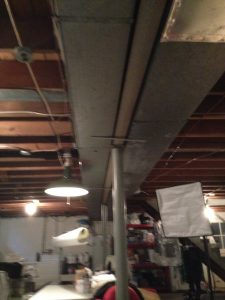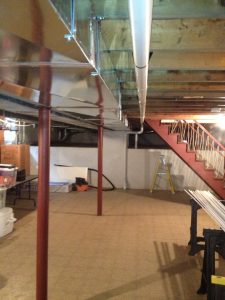
Vince DiFilippo is the president of DiFilippo’s Service Co., Paoli, PA.
We face one consistent obstacle at DiFilippo’s Service Company — two-story homes built above short basements. Many were originally designed for heating, not cooling. We also encounter short basements where larger, where others forced efficient equipment to fit into tight, finished spaces. In short, many houses have upper floors where we cannot add duct work. These situations present challenges that require creativity to resolve.
There will be times when a house beats you and you can’t do much. We don’t give up. Why? Because you can make significant improvements at or near the equipment. So our company runs into a lot of issues associated with return ducts, or lack of them. In this article, I’ll focus on three ways DiFilippo’s solves return obstacles in basements.

Figure 1: Enlarge the Return Drop
Enlarge the Return Drop
The number one return upgrade we perform is to increase the return drop size. Most return drops we encounter are drastically undersized. When we enlarge these ducts, we also add turning vanes to the elbows to allow for smooth airflow.
There are many systems in our area with five-ton blowers and one return drop. The equipment can’t function properly partially because airflow chokes at the inlet. Typically, these systems run at very high total external static pressures (TESP) and low fan airflow. Following are some typical examples we’ve encountered and what we did to fix them.

Figure 2: Second Example of Enlarging the Return Drop
For example, in Figure 1, note that this five-ton system was originally installed with a single return drop in one side. The TESP was excessive and fan airflow was low. So our team added a second properly-sized return drop and filter to reduce static pressure and increase airflow. In this case, we were lucky to have the room to add that second return drop and additional return ducts. Some basements aren’t that open and options are limited.
In Figure 2, we encountered a home that limited the options we could offer. The five-ton system was installed with a single return drop tied into the right side of the furnace. To correct the static pressure and airflow issues, we lifted the furnace and brought in a properly-sized return drop to its side and bottom.
Increase Return Trunk Duct Size
The second most common return upgrade we perform is increasing the size of the return trunk to the equipment. Having a properly-sized return drop is useless if return air can’t make it back from the return grilles to the equipment.

Figure 3: Increase Return Duct Size – Before work was done.
On the system depicted in Figure 3, there was no chance for return air to make it back to the equipment. We had no choice but to completely redo the return trunk with one that could handle the right amount of airflow.
Depending on the style of the house, a complete redo of the return trunk might not be needed. In some instances, we only need to replace a few sections of duct.
To maintain headroom, Figure 4 shows how we made the return trunk wider so it would not fall below the beam. Airflow through the return grilles increased and return duct pressure dropped substantially once this upgrade was finished.

Figure 4: Increase Return Duct Size – After work is completed.
Add Return Ducts
There will be times when even a properly-sized return drop and trunk won’t deliver needed air. In those cases, we look for alternative ways to get additional return to the system. Some house layouts are easy to add a floor return in an open area , others require more creativity.
In the system shown in Figure 5, we encountered tight access and had to add a return grille to the toe kick of the stairs. The homeowner’s den had no return and couldn’t recirculate air from the room as needed.

Figure 5: Step Down Return Grill
If you add a return duct, be sure air isn’t pulled from an area with natural draft gas-fired equipment in it. You could create a dangerous situation and a potential for CO poisoning.
Don’t Forget
While this is a look at one of the most common things we see, don’t forget the supply side of the system. We see a lot of supply problems and repairs are often necessary on the air delivery system and not the equipment. Be sure to look at the entire system.
How do you handle these challenges and guarantee a customer’s comfort? We’d love to hear some of your creative solutions. Please drop us a note at ContactUs@HVACToday.com or feel free to comment.
Meet Vince DiFilippo at NCI Summit 2018 Come meet Vince and network with your peers in Austin. Learn more about the Summit 2018 program at GoToSummit.com. JOIN US FOR SUMMIT, STAY FOR SOUTH-BY-SOUTHWEST MUSIC FESTSummit 2018 offers you and your team the opportunity to not only hear from some of the Performance-Based HVAC Industry’s finest, but also a chance to network with like-minded contractors from across the nation. Take advantage of Early Bird pricing by registering today. Questions? No problem. Call 800-633-1850 and talk to your customer care representative. After Summit ends, stick around for our Post Show Training classes and then head into downtown Austin for one of the world’s best music festivals, South by Southwest. Click here for details. |



 High Performance HVAC Summit 2018
High Performance HVAC Summit 2018









Recent Comments